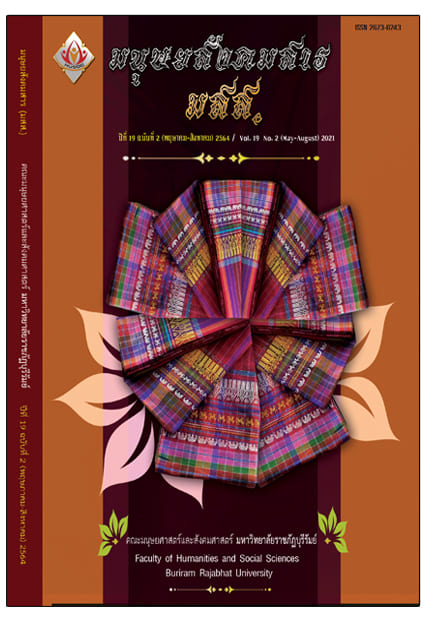การศึกษาวัฒนธรรมทางดนตรีของวงมโหรีพื้นบ้านอีสานใต้: กรณีศึกษา วงมโหรีพื้นบ้าน บ้านสะเดา อำเภอพลับพลาชัย จังหวัดบุรีรัมย์
Main Article Content
บทคัดย่อ
การวิจัยครั้งนี้ มีวัตถุประสงค์ คือ 1) เพื่อศึกษาความเป็นมา องค์ประกอบและวัฒนธรรมทางดนตรีของวงมโหรีพื้นบ้านอีสานใต้ 2) เพื่อวิเคราะห์บทเพลงพื้นบ้านอีสานใต้ 3) เพื่อศึกษาการเปลี่ยนแปลงทางดนตรีของวงมโหรีพื้นบ้านอีสานใต้ เป็นการวิจัยเชิงคุณภาพ (Qualitative Research) มีการลงพื้นที่ภาคสนาม ณ หมู่บ้านสะเดา ตำบลสะเดา อำเภอพลับพลาชัย จังหวัดบุรีรัมย์ ประชากรและกลุ่มตัวอย่างเป็นศิลปินในชุมชนจำนวน 10 คน ใช้เครื่องมือวิจัยแบบสัมภาษณ์เชิงลึกและ การสนทนากลุ่ม วิเคราะห์ข้อมูลด้วยวิธีการพรรณนาบรรยาย ผลการวิจัยพบว่า
- 1. องค์ประกอบและวัฒนธรรมทางดนตรีของวงมโหรีพื้นบ้านอีสานใต้มีส่วนสำคัญที่ทำให้วัฒนธรรมทางดนตรีเกิดความสมบูรณ์ คือ การก่อตั้งวงดนตรีที่เกิดจากการสืบทอดภูมิปัญญาของศิลปินท้องถิ่น โดยมีเครื่องดนตรีที่มีการจัดรูปแบบของวงมโหรีพื้นบ้านอีสานใต้อย่างสมบูรณ์ ได้แก่ ปี่สไล ซอด้วง ซอกลาง ซออู้ กระปือ จับเปย กลองใหญ่ กลองกันตรึม ฉิ่ง ฉาบเล็ก และกรับ บรรเลงบทเพลงที่ได้รับการสืบทอดแบบมุขปาฐะทั้งเพลงบรรเลงและเพลงขับร้อง มีวัฒนธรรมความเชื่อว่าก่อน การบรรเลงทุกครั้งจะประกอบพิธีบูชาครูด้วยเครื่องสังเวยตามประเพณี วงดนตรีจะบรรเลงประกอบพิธีกรรมและกิจกรรมตามประเพณีสำคัญของชุมชน
- 2. บทเพลงบรรเลงจะเป็นเพลงสั้น ๆ มีโครงสร้างของบทเพลงอย่างชัดเจน มีสำเนียงเพลงบรรเลงที่แสดงถึงคีตลักษณ์ทางดนตรีพื้นบ้าน ใช้ระบบเสียงแบบ Pentatonic มีวรรคเพลงและประโยคเพลงชัดเจน บรรเลงขึ้นหัวเพลงด้วยเครื่องนำและบรรเลงทอดลงจบอย่างสมบูรณ์
3. การเปลี่ยนแปลงของวัฒนธรรมทางดนตรีเกิดขึ้นในหลายมิติ คือ เกิดจากตัวบุคคล รูปแบบกระบวนการสืบทอดของนักดนตรี การรวมวงดนตรี และการบรรเลงบทเพลงต่าง ๆ ทั้งการบรรเลงเพลงเพื่อประกอบงานทั่วไป เพลงประกอบพิธีกรรมและเพลงประกอบการแสดง
Article Details

อนุญาตภายใต้เงื่อนไข Creative Commons Attribution-NonCommercial 4.0 International License.
เนื้อหาและข้อมูลในบทความที่ลงตีพิมพ์ในวารสารทดสอบระบบ ThaiJo2 ถือเป็นข้อคิดเห็นและความรับผิดชอบของผู้เขียนบทความโดยตรงซึ่งกองบรรณาธิการวารสาร ไม่จำเป็นต้องเห็นด้วย หรือร่วมรับผิดชอบใดๆ
บทความ ข้อมูล เนื้อหา รูปภาพ ฯลฯ ที่ได้รับการตีพิมพ์ในวารสารทดสอบระบบ ThaiJo2 ถือเป็นลิขสิทธิ์ของวารสารทดสอบระบบ ThaiJo2 หากบุคคลหรือหน่วยงานใดต้องการนำทั้งหมดหรือส่วนหนึ่งส่วนใดไปเผยแพร่ต่อหรือเพื่อกระทำการใดๆ จะต้องได้รับอนุญาตเป็นลายลักอักษรจากวารสารทดสอบระบบ ThaiJo2 ก่อนเท่านั้น
เอกสารอ้างอิง
Binson, B. & Pornprasit, K. (2015). Mahori southern Isan. Bangkok: Chulalongkorn University Printing House. [in Thai]
Nawikkamun, A. & Pidokrajt, N. (2007). Folk songs. Bangkok: Sarakadee Lite On behalf of Viriyah Business Co., Ltd [in Thai]
Ninsuk, P. (24 April 2021). Lyrics. (Panasin Sriviset, Interviewer). [in Thai]
Pikilsri, C. (2017). Musical changes. Khon Kaen: Anna Offset Printing House. [in Thai]
Ruangdej, P. (1986). Kantreum southern Isan folk. Buriram: Cultural center United College of North Isan-Buri Ram. [in Thai]
Rungruang, P. (2003). History of Thai music. Bangkok: Thai Wattana Panit Co., Ltd [in Thai]
Sudsangsang, P. (17 January 2021). Mahori folk song band. (Panasin Sriviset, Interviewer). [in Thai]
Visutpat, M. (1990). Analysis of Thai music. Bangkok: Chwn Pim Printing House. [in Thai]
Wicharachok, K. (17 January 2021). Mahori folk song. (Panasin Sriviset, Interviewer). [in Thai]


